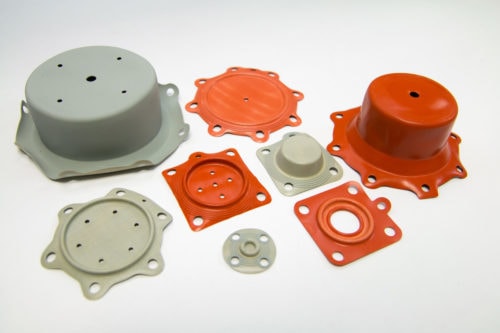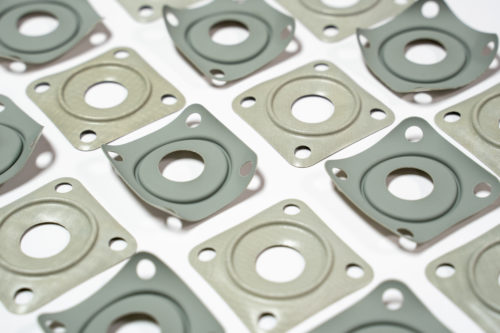The Complete Rubber Molding Guide
What Is Rubber Molding?
Rubber molding is a manufacturing process that turns uncured rubber and other elastomeric materials into usable parts and products. It involves placing, pressing, or injecting the material into the cavity of a metal mold. Then, pressure and heat are applied, which initiates a chemical reaction—i.e., curing or vulcanization—within the material. The chemical reaction prompts the material’s long polymer chains to crosslink, preventing them from moving independently and enabling the material to expand and contract when stress is applied or removed.
In general, this process can be used to form a wide range of parts and products for various industries. Additionally, it can be utilized to manufacture both standard and custom components. While standard components can come in a variety of designs, materials, and sizes to accommodate different applications, an off-the-shelf solution may not always be suitable. Custom components are often a more appropriate solution for applications with exacting specifications.
Below, we provide an overview of the custom rubber molding process. We discuss the materials commonly used in rubber molding operations, describe the types of rubber molding methods available, outline the steps of the custom rubber molding process, highlight typical custom-molded rubber parts and products, and explain why you should consider a custom component.
Commonly Used Materials in Rubber Molding Operations
While the materials used in the rubber molding process can be made from natural compounds, they are typically synthetic. In either case, they have sufficient dimensional resilience to ensure components made out of them return to their original shape without damage after being subjected to pressure and other distorting forces.
Some of the material typically utilized in rubber molding operations include:
- This material operates across a broad temperature spectrum and is used in many aerospace applications. Silicone is available in high-purity grades, which is ideal for high-sanitation applications (e.g., food processing or pharmaceutical manufacturing). It also demonstrates excellent resistance to ozone and UV radiation but poor resistance to abrasion, various chemicals, and tearing.
- This material offers the same thermal range and stability as silicone but better resistance to fuels, grease/oil, and solvents.
- This general-purpose material is used in many applications. However, it is not suitable for use in environments where exposure to strong acids, esters, ketones, and hydrocarbons is likely.
- This material is good for components that may come into contact with fuel, grease, oil, or solvents but bad for components that may come into contact with chlorinated hydrocarbons and ketones.
- This material exhibits excellent ozone and UV resistance across a wide range of temperatures. However, it is susceptible to degradation from certain hydrocarbons, oils, and petroleum products.
- This specialty material has a wide operating temperature range. It is also extremely insulating and flame resistant.
Types of Rubber Molding Methods
There are many variations of the rubber molding process. Three of the most commonly used are compression molding, injection molding, and transfer molding. While each variant relies on heat and pressure to create molded rubber components, it also offers unique advantages and disadvantages that make it suitable for particular manufacturing applications. For example:
- Compression molding is generally used to manufacture simple parts and products. It offers the most part size flexibility of the three main rubber molding variations but is more limited with regard to precision and accuracy. It is also highly cost-effective for medium-volume production projects, offering low material waste, low cost tooling, and fast lead times.
- Injection molding is ideal for producing parts and products with tight tolerance requirements. It can achieve high precision and accuracy. However, it requires more expensive tooling. As a result, it is best suited for medium to high-volume production runs.
- Transfer molding is perfect for rubber molding projects that require tight control over dimensional tolerances. It is precise, accurate, and quick for medium to low volume production. However, it can produce more material waste, so it is generally used to mold inexpensive materials with moderate tooling cost.
Another variant of the rubber molding process is rubber-to-metal bonding. As the name suggests, it involves the bonding of a rubber material to a metal material. The resulting assembly has the strength of metal and the flexibility of rubber. However, forming a durable bond between the materials can be challenging, which is why it is important for the molder performing the operation to have proper knowledge about and extensive experience with the process.
Steps in the Custom Rubber Molding Process
While the custom rubber molding process may vary slightly from method to method and project to project, it typically consists of the following steps:
- Creating a CAD model for the desired component
- Designing the mold needed to create the component from the 3D model
- Producing the mold for the rubber molding process
- Using the mold to produce prototypes and, if the prototypes are suitable, full production units
- Sending the molded rubber components for further processing, if needed
Since mold makers need the CAD model to produce the mold for the desired component, it is best practice to check with your custom molding company to identify which file types are accommodated. IGES is one of the most commonly used. Additionally, you may include a print that provides notes, specifications, tolerances, and other important information to better ensure your molding partner produces an accurate representation of your part or product concept. While this information should typically be provided in a PDF, some companies accept other file formats.
Typical Custom-Molded Rubber Parts & Products
The custom rubber molding process offers broad design flexibility. It can be used to create a variety of parts and products for various industries and applications. Typical custom-molded rubber components include:
- Bumpers
- Bushings
- Diaphragms
- Grommets
- Isolators
- Mounts
- Plugs
- Seals
- Composite Seals (Rubber-To-Metal Bonding)
Whether you need bumpers, grommets, seals, or another custom-molded rubber component, your molding partner should have the experience and expertise to produce parts and products that meet your specifications and standards. The experts at Micro-Tronics have what it takes to manufacture quality components for the aerospace, industrial, medical, food, commercial, and military industries.
Why Should You Consider a Custom-Molded Rubber Part?
Standard molded rubber parts and products are suitable for many applications. However, they are not appropriate for every application. Any company that produces and/or uses heavy or precision machinery may require custom-molded rubber components at one point or another. By customizing specific parts and products, you can achieve safer working conditions, better system operation, simpler assembly requirements, and longer equipment life, all of which can save you time and money.
The key advantages of choosing a custom-molded rubber part over a standard molded rubber part include:
- Broader material freedom. You can select the material that best suits your needs. Whether you need specific strength, hardness, or stretch properties, you can tailor the component to perform in a particular way within the application environment. This is especially important for components intended for use in environments with harsh conditions (e.g., high/low temperatures or strong chemicals). Stock components often force you to compromise on one or more of the desired performance factors.
- Better component performance. The better a molded rubber component fits, the better it will perform. While it is possible to find stock components that seem to fit on or in an assembly, custom components will almost always work better as it is specifically designed and constructed to suit the application and environment.
- Longer component service life. In addition to having better performance characteristics, custom-molded rubber components often have longer service lives than standard molded rubber components. As a result, they help keep equipment running for longer, which saves time and money by reducing the need for repair and replacement.
- Simpler assembly and lower cost. In elastomer-to-metal bonded seals, the sealing elements are precisely and permanently molded into place. This means two components can be combined into one without needing additional mating hardware, which reduces assembly complexity and part cost.
Partner With Micro-Tronics, Inc. for Your Custom-Molded Rubber Needs
Looking for a custom rubber component manufacturing partner? The experts at Micro-Tronics, Inc. are here to help!
At Micro-Tronics, Inc., we are an industry-leading manufacturer of precision rubber components. Equipped with over 50 years of manufacturing experience, more than 150 engineering, manufacturing, and customer service experts, and an extensive selection of materials and manufacturing equipment, we have what it takes to deliver high-quality molded rubber parts and products on time and on budget.
Some of the elastomer components we produce include:
- Cloth-reinforced diaphragms
- Rubber-to-metal bonded seals
- Industrial components
- Solid rubber components, such as grommets, seals, bumpers, boots, caps, and tubes
- Assemblies that include rubber molded products
To learn more about our products and services, contact us today. To discuss your custom-molded rubber needs with one of our experts, request a quote.







